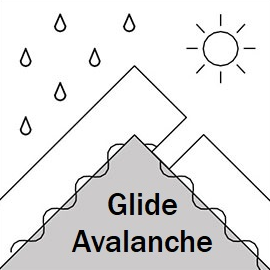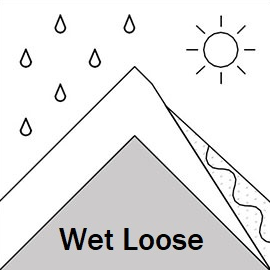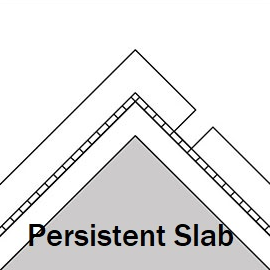Gudauri
Natural avalanches are unlikely, human-triggered avalanches are possible. Small avalanches in specific areas, or large avalanches in isolated areas.
New snow will begin later on Sunday. A high freezing level means loose wet avalanches and glide slabs are possible in the sub-alpine. Take care at high elevations where the snowpack is rocky, shallow and steep, as the recent cold snap could have promoted facet (weak layer) formation there.
Forecast issued at: 20 January 2024 23:00
Forecast valid until: 21 January 2024 23:00
Forecaster: Manu Greer
High Alpine
> 2600m
1 Low
Generally safe avalanche conditions. Watch for unstable snow on isolated terrain features.
Alpine
2000m - 2600m
1 Low
Generally safe avalanche conditions. Watch for unstable snow on isolated terrain features.
Sub Alpine
< 2000m
2 Moderate
Heightened avalanche conditions on specific terrain features. Evaluate snow and terrain carefully; identify features of concern.
Avalanche Problems
Glide

With mild day time temperatures, we expect glide cracks and full-depth glide avalanches to remain active. They are common around the Gudauri region, and will be with us for the rest of the season. These avalanches can release randomly on all aspects, even at night, although rapid warming makes them more likely. Do not stop under steep areas if there are cracks above you. Remember that new snow or wind-drifting can disguise these cracks.
| Sensitivity | The specific avalanche problem type is reactive to human rider triggers. Easy to trigger with ski cut. |
| Distribution | A few, isolated locations; evidence for instabilities is rare and hard to find. |
| Time of Day | All day |
| Trend | Deteriorating |
| Confidence | Moderate |
Loose Wet

Mild temperatures may lead to natural or skier-triggered loose wet avalanches in steep terrain, especially in lower elevations. While this is mostly a sub-alpine issue, watch out for the loose snow problem pushing into the lower part of the alpine zone midday tomorrow before the temperature drops.
| Sensitivity | The specific avalanche problem type is reactive to human rider triggers. Easy to trigger with ski cut. |
| Distribution | Specific areas, with common characteristics. Evidence for instabilities exists, but it is not obvious and finding it requires careful observations. |
| Time of Day | Afternoon |
| Trend | Deteriorating |
| Confidence | Moderate |
Persistent Slab

Weak layers associated with melt-freeze crusts or density changes have been found in a couple of spots recently, and cold temperatures have made the layers weaker. These weaknesses probably need a large load to set them off, but with new snow adding weight, watch this space! Probably only found in isolated areas, although there is still uncertainty - we need more information, so please let us know what you find out there.
| Sensitivity | The specific avalanche problem type is difficult to trigger with a human rider. |
| Distribution | A few, isolated locations; evidence for instabilities is rare and hard to find. |
| Time of Day | All day |
| Trend | No change |
| Confidence | Moderate |
Recent Avalanches and Snowpack
Avalanche Activity:
18th January - New size 2 Glide slab seen in Khada valley, E aspect, 2200m?
16th January - Skier triggered size 1 wind slab, 2500m, NE aspect Milioni valley, 20cm deep, 20m wide, ran 5m off a steep bank.
Snowpack:
Strong W and SW winds last weekend hammered the snow surface on most aspects in the high alpine, creating slabs and poor ski quality. These slabs should have stabilised by now. Sheltered areas in lower elevations hold better snow but there will be a crust below about 2000 m due to recent melt-freeze cycles. We currently have a relatively stable snowpack, but the recent cold temperatures have weakened some snow layers above 2000m, and feathery surface hoar crystals have been seen in some shady areas in the alpine zone. Weak, faceted snow can be found in shallow rocky areas near ridges at higher elevations, and a melt-freeze crust with facets above it was found on an E aspect at 2970m. Whumphing was reported from Lomisa area, NE aspect, 2100 m.
Check recent profiles at snowpilot.org
Weather
Warm temperatures over the last two days with high solar input, light winds, and clear skies at night.
Sunday 21st: Clouds developing in the morning with light snow starting in the afternoon and becoming heavier in the evening. Relatively warm with a freezing level of 2100m during the day, lowering to 1650m at night. Winds light SW.
Disclaimer
Our avalanche forecasters are internationally qualified and experienced professionals, and data is provided by skilled observers. We encourage you to make your own observations and decisions, without relying solely on our forecast, since any forecast is a generalised 'best guess', and in certain cases it might be inaccurate. We can not be held liable for any actions you take in the backcountry that may result in injury, loss or death.